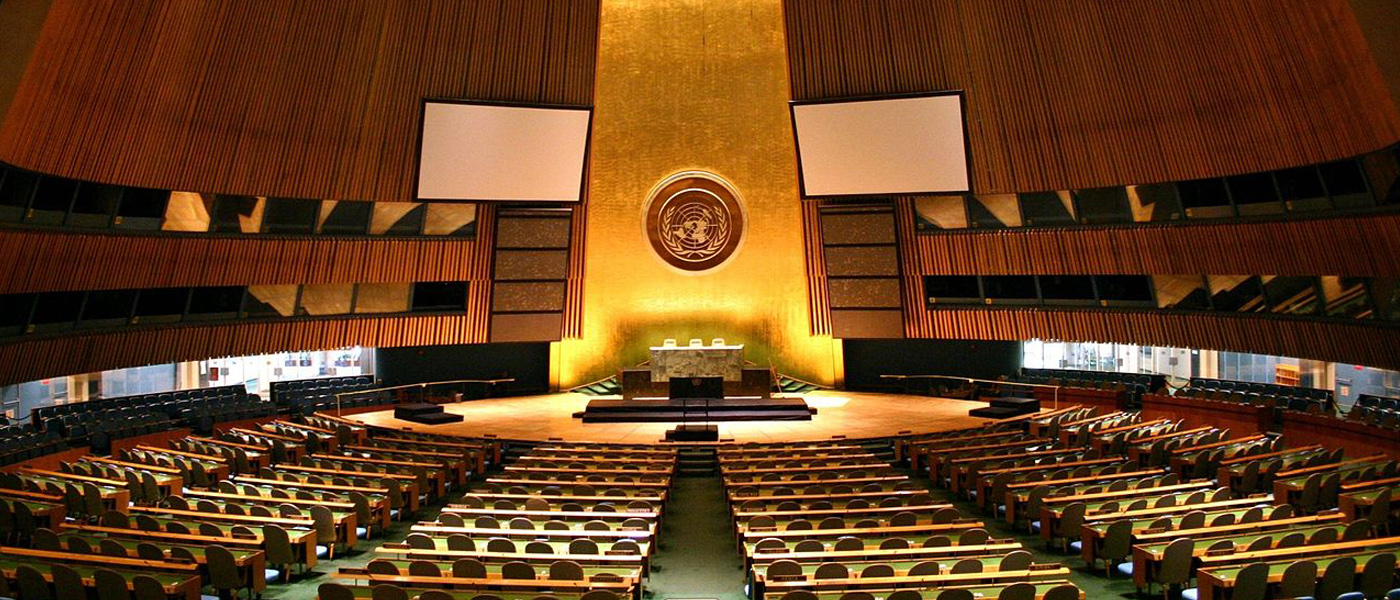
Introduction
The world has changed a lot since the United Nations first convened in the General Assembly at its headquarters above the East River in New York City. UN membership, for one, has swelled from 51 to 193 countries, straining the General Assembly Hall well beyond its intended capacity of providing room for representatives of 75 nations. So much growth and decades of wear had taken its toll on the venerable space that by 2008, the UN began a full renovation of its entire 6-building campus, a four-phase project to restore and modernize the entire headquarters complex inside and out. Today, the General Assembly Hall’s famed dome and frescos are restored, and the colors are clean and vibrant. The haze that once hung over the proverbial smoke-filled room has dissipated, its residue scrubbed from the fixtures, ceilings, and floors where diplomats negotiated a half-century worth of resolutions, treaties, and history. As the UN’s Werner Schmidt, information specialist on the renovation, described, the room looks much like it did when it first opened in 1952—but its new underlying AV infrastructure makes it much more efficient for its members and the public. “All of the electronics had aged, some not so gracefully, and they were in dire need of a thorough upgrade, which has now happened,” said Schmidt when the General Assembly reopened after the renovation. “We tried to blend in state-of-the-art electronics within this historic context.”
AV for the UN
Now with 193 member countries and space for 204, the revamped General Assembly has a new, efficient audiovisual network, with robotic cameras that James Bondera diplomats would covet capturing and broadcasting images and sound as the myriad talking heads contribute to negotiations throughout the chamber. The assembly relies on an on-site, 24/7 broadcast facility to deliver the audio and video to broadcast feeds and closedcircuit screens located throughout the main hall, and to screens of all sizes in conference rooms throughout its 17-acre campus. While its outputs deliver crisp, broadcast-ready SDI signals, the range of inputs are rooted in traditional AV, driving the need for an efficient way to convert an army of HDMI and other assorted sources from laptops and TV screens and sync them for broadcast. VCA Global, the New York-based technology integrator responsible for the General Assembly phase of the project, deployed a line of nine PureLink matrix switchers in the chamber to interface the disparate systems.
The PureLink Advantage
“The PureLink matrix switcher can cross convert all video and broadcast formats in one chassis, so I can take any source and connect it to any output,” said Mattias Allevik, senior project engineer and the project manager at the UN General Assembly for VCA. “With broadcast, everything is synchronized to routing and times, whereas AV is asynchronous. PureLink has the ability to take AV and make it synchronous with broadcast facility needs.” Allevik brought PureLink’s flagship PM-128×128 matrix switcher to the project, along with three 64×64 frames, three 48×48, and one each 16×16 and 8×8. The matrix units take inputs from the computers, cameras, and other AV equipment and output to the facility’s core 500×1540 broadcast router, which takes feeds from all of the conference rooms on campus. “One of the key things for the client was to improve upon what they had done previously, which was limiting,” said Howard Schilling, director of sales at PureLink. Replacing scores of format conversions in the former hybrid TV/video environment to make the systems “talk” was firmly in the PureLink switchers’ wheelhouse. “The PM series removes that limiting factor because it combines 3G/HD-SDI, DVI, HDMI, Fiber and HDBaseT all in one chassis, and those boards go all the way up the line. You have the ability to use copper on both sides of any size matrix, and they were able to combine fiber and copper.”
ALAS was brought on to implement PureLink’s VIP-300 IP Video Distribution System in a 10×45 matrix all utilizing PureLink’s VPX control automation software. The VPX IP Video Management Software offers advanced system tools that simplify setup and operation of the system, including automatic discovery of VIP transmitter and receiver modules, preset and automation schedule creation, external control API, detailed diagnostic reporting, and more. The flexibility and ease of integration offered by PureLink’s VIP/VPX product line also allowed the VIP-300 system to work transparently with the existing Juniper network switches.
Another key factor in the project was ensuring a seamless environment without delays in audio and video transmission. As Schilling put it, the UN General Assembly presents “the most mission-critical conference room in the world.” Seamless switching in this application isn’t merely a professional-looking luxury, it is paramount. Where other switchers lag or blink, PureLink’s proprietary scaling engine provides a virtually instantaneous switch. “What PureLink can do that competing products can’t is provide glitch-free sources for display,” said Allevik. “It’s a fundamental requirement for what the client needed.” In a project this large spanning several facilities over multiple years—not to mention contracts—sometimes the most critical issues can arise when one integrator is tasked with piecing together their part with another contractor’s work. Differences in systems specifications from one phase of construction to another also played a role in Allevik specifying PureLink. “The difficult part in the conference building phase was all the other contracts,” he said. “They had a design build contract, but ultimately it wouldn’t work how the client specified the use.” Allevik knew that the PureLink switchers’ scalability and seamless switching would solve the problem, so he convinced them to change the project specification into a design instead. Schilling said, “We’ve made our name fixing problems that the competition could not. When confronted with this issue, VCA thought of us. They knew about our cross-platform architecture, going from broadcast to AV, and the fast switching. It turned out to be a perfect fit.
-Written by Jim Beaguez, SCN Magazine (October 2015)




Add comment
You must be logged in to post a comment.